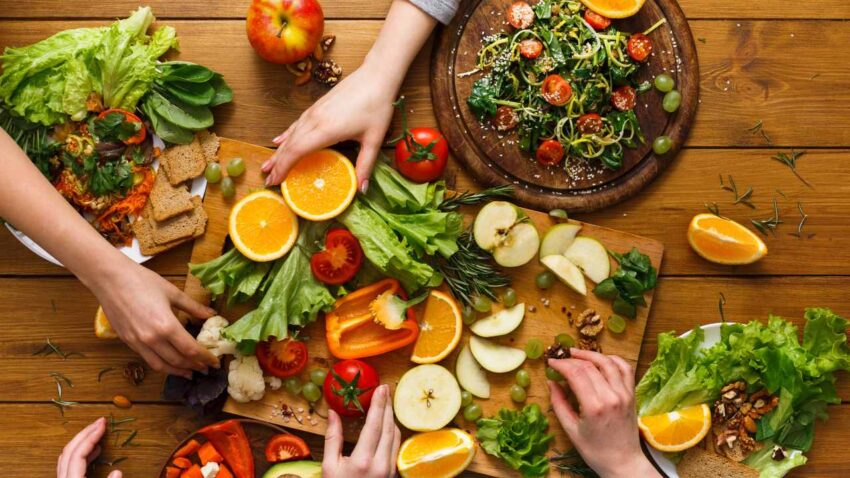In today’s fast-paced world, making healthy food choices is more crucial than ever. Our diet plays a pivotal role in preventing chronic illnesses, boosting immunity, supporting mental health, and enhancing overall well-being. But with so many dietary trends and conflicting advice, identifying truly healthy foods can be overwhelming.
This guide answers one of the most frequently asked nutrition questions: “What are the 10 most healthy foods?” These foods are not only rich in essential nutrients but also backed by scientific research and recommended by trusted health authorities like the and the Let’s dive deep into the top 10 healthiest foods and discover how they can benefit your mind and body.
Leafy Green Vegetables (Spinach, Kale, Swiss Chard)
Why They’re Healthy:
Leafy greens are nutrient-dense, low in calories, and packed with:
-
Vitamins A, C, K, and folate
-
Iron, calcium, and fiber
-
Powerful antioxidants like lutein and zeaxanthin
These nutrients support bone health, eye health, and immune function.
How to Eat Them:
-
Add kale or spinach to smoothies
-
Use them as salad bases
-
Stir them into soups and stews
Berries (Blueberries, Strawberries, Raspberries)
Why They’re Healthy:
Berries are among the most antioxidant-rich foods available. They:
-
Combat oxidative stress
-
Improve brain health
-
Reduce the risk of heart disease
They’re also high in fiber, which helps regulate blood sugar and supports digestion.
How to Eat Them:
-
Add to yogurt or oatmeal
-
Blend into smoothies
-
Enjoy as a healthy snack
Fatty Fish (Salmon, Mackerel, Sardines)
Why They’re Healthy:
Fatty fish are an excellent source of omega-3 fatty acids, protein, and vitamin D. These nutrients help:
-
Reduce inflammation
-
Lower blood pressure
-
Improve brain and heart health
How to Eat Them:
-
Grill or bake salmon with herbs
-
Make sardine toast or fish salads
-
Add mackerel to rice bowls
Nuts (Almonds, Walnuts, Pistachios)
Why They’re Healthy:
Nuts are high in:
-
Healthy fats (monounsaturated and polyunsaturated)
-
Protein
-
Magnesium and vitamin E
They help reduce the risk of heart disease, control appetite, and manage blood sugar.
How to Eat Them:
-
Snack on a handful of raw nuts
-
Sprinkle over salads or oatmeal
-
Add to baked goods
Whole Grains (Quinoa, Brown Rice, Oats)
Why They’re Healthy:
Whole grains contain all parts of the grain—bran, germ, and endosperm—offering:
-
Fiber
-
B vitamins
-
Iron and magnesium
They help with digestion, blood sugar control, and weight management.
How to Eat Them:
-
Cook oatmeal for breakfast healthy foods
-
Use quinoa as a base for grain bowls
-
Replace white rice with brown rice
Cruciferous Vegetables (Broccoli, Cauliflower, Brussels Sprouts)
Why They’re Healthy:
Cruciferous veggies are rich in:
-
Sulforaphane, an anti-cancer compound
-
Fiber
-
Vitamin C and folate
These vegetables support detoxification, hormone balance, and cancer prevention.
How to Eat Them:
-
Roast with olive oil and spices
-
Add to stir-fries
-
Blend into soups
Avocados
Why They’re Healthy:
Avocados are unique in that they are fruits rich in:
-
Heart-healthy monounsaturated fats
-
Potassium (more than bananas!)
-
Fiber and antioxidants
They support heart health, brain function, and skin health.
How to Eat Them:
-
Make guacamole
-
Slice on toast or salads
-
Blend into smoothies
Garlic
Why It’s Healthy:
Garlic has been used for centuries for its medicinal properties. It:
-
Supports immune function
-
Lowers cholesterol and blood pressure
-
Contains allicin, a powerful compound
How to Eat It:
-
Mince raw garlic into dressings
-
Roast and spread on toast
-
Add to soups and sauces
Trusted Source: NIH – Garlic and Health
Greek Yogurt
Why It’s Healthy:
Greek yogurt is high in:
-
Protein
-
Probiotics
-
Calcium and potassium
It aids in gut health, muscle maintenance, and bone strength.
How to Eat It:
-
As a base for smoothies
-
Topped with berries and nuts
-
Used in sauces and dips
Legumes (Lentils, Chickpeas, Black Beans)
Why They’re Healthy:
Legumes are an affordable source of:
-
Plant-based protein
-
Fiber
-
Iron, magnesium, and B vitamins
They promote heart health, weight control, and blood sugar regulation.
How to Eat Them:
-
Make lentil soup
-
Add black beans to tacos
-
Blend chickpeas into hummus
Conclusion
Eating healthy doesn’t mean giving up flavor or satisfaction. The ten healthy foods outlined above—leafy greens, berries, fatty fish, nuts, whole grains, cruciferous vegetables, avocados, garlic, Greek yogurt, and legumes—are packed with nutrients that promote longevity, disease prevention, and daily energy.
Incorporating even a few of these superfoods into your diet can dramatically improve your health. Rather than chasing trends or eliminating entire food groups, focus on adding these nutrient-dense options to build a balanced, sustainable diet.
Frequently Asked Questions (FAQ)
Q1: Can I eat all these foods every day?
Yes, in moderation. Most of these foods can be part of your daily diet. Balance is key.
Q2: Are these foods suitable for vegans?
Most are vegan-friendly. Fatty fish and Greek yogurt are not, but alternatives like tofu and plant-based yogurts work well.
Q3: What if I have a nut allergy?
You can replace nuts with seeds like sunflower, chia, or flaxseeds, which also provide healthy fats and nutrients.
Q4: How do I store these foods to keep them fresh?
Use airtight containers, refrigerate perishables, and buy in small quantities to reduce waste.
Q5: Are these foods expensive?
Many are affordable, especially legumes, oats, and seasonal produce. Buying in bulk can reduce costs further.
